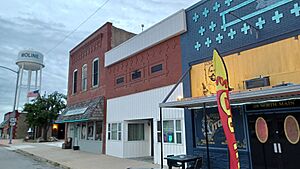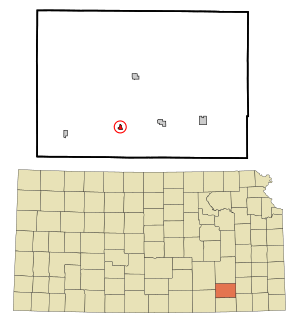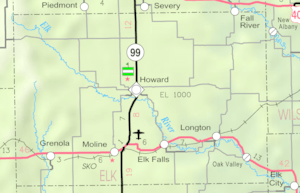Moline, Kansas facts for kids
Quick facts for kids
Moline, Kansas
|
|
|---|---|

Moline (2022)
|
|

Location within Elk County and Kansas
|
|

|
|
| Country | United States |
| State | Kansas |
| County | Elk |
| Founded | 1879 |
| Incorporated | 1886 |
| Named for | Moline, Illinois |
| Government | |
| • Type | Mayor–Council |
| Area | |
| • Total | 0.34 sq mi (0.87 km2) |
| • Land | 0.34 sq mi (0.87 km2) |
| • Water | 0.00 sq mi (0.00 km2) |
| Elevation | 1,053 ft (321 m) |
| Population
(2020)
|
|
| • Total | 345 |
| • Density | 1,015/sq mi (396.6/km2) |
| Time zone | UTC-6 (CST) |
| • Summer (DST) | UTC-5 (CDT) |
| ZIP code |
67353
|
| Area code | 620 |
| FIPS code | 20-47600 |
| GNIS ID | 2395366 |
Moline is a small city in Elk County, Kansas, United States. It is located in the south-central part of Elk County. In 2020, about 345 people lived there. Moline sits where two main roads meet: U.S. Highway 160 and K-99.
Moline is famous for having Kansas's oldest swinging bridge. This bridge was built in 1904. It crosses over a part of Wildcat Creek. Near the bridge, there is also a cool limestone waterfall. It flows with water a lot during the rainy season.
Contents
History of Moline
Moline is built on a slightly raised area near Wildcat Creek. Native Americans named the creek because many wildcats, also known as Bobcats, lived there. In early 1879, the Santa Fe Railway was building tracks west. New towns quickly appeared along the railway line.
The land for Moline was officially set aside on July 21, 1879. The town was named Moline because Mr. J.F. Chapman suggested it. He was from Moline, Illinois. Also, many farmers in the area used plows made by the Moline Plow Company. The first post office in Moline opened in September 1879.
Geography of Moline
Moline is a small city. According to the United States Census Bureau, it covers about 0.35 square miles (0.87 square kilometers). All of this area is land.
Population of Moline
Moline has seen its population change over the years. Here's how many people have lived there during different census counts:
| Historical population | |||
|---|---|---|---|
| Census | Pop. | %± | |
| 1880 | 79 | — | |
| 1890 | 527 | 567.1% | |
| 1900 | 695 | 31.9% | |
| 1910 | 808 | 16.3% | |
| 1920 | 950 | 17.6% | |
| 1930 | 897 | −5.6% | |
| 1940 | 870 | −3.0% | |
| 1950 | 871 | 0.1% | |
| 1960 | 698 | −19.9% | |
| 1970 | 555 | −20.5% | |
| 1980 | 553 | −0.4% | |
| 1990 | 473 | −14.5% | |
| 2000 | 457 | −3.4% | |
| 2010 | 371 | −18.8% | |
| 2020 | 345 | −7.0% | |
| U.S. Decennial Census | |||
Moline's Population in 2020
In 2020, the 2020 United States census counted 345 people living in Moline. There were 146 households in the city. About 24.9% of the people were under 18 years old. The median age was 49.9 years. This means half the people were younger than 49.9 and half were older.
Education in Moline
Students in Moline attend schools in the West Elk USD 282 public school district. This district was formed when schools from Moline, Howard, and Severy joined together. West Elk High School is located in Howard. The school's mascot is the Patriots.
Moline used to have its own high school, Moline High School. Its mascot was the Hornets. However, it closed when the schools combined.
Museums in Moline
Shaffer House Museum and Art Center
Moline is home to the historic Shaffer House Museum and Art Center. You can find it at the corner of 2nd and Plum Streets. This three-story building was first a place where people could rent rooms. Later, it became a doctor's office and hospital run by Dr. C.E. Shaffer.
Local volunteers run the Shaffer Museum. It is open from May to August on Wednesdays and Saturdays, from 9 A.M. to 12 P.M. It's free to visit! The museum shows what a kitchen and bedroom looked like in the early 1900s. It also has a photographer's studio from 1917. You can see old medical tools and farming equipment. There are also items from the Ames Chevrolet dealership. This dealership was once the oldest family-owned Chevrolet dealership in the U.S. The museum also has items from local schools, including the old Moline High School. Plus, you can learn about General Leon Johnson. He was a World War II aviation hero who grew up in Moline.
Community Festivals and Events
Moline Crazy Days
"Crazy Days" is a fun festival in Moline that everyone can enjoy. It happens every year during the last full weekend of June. The event takes place at Griffin City Park.
On Friday evening, the festival starts with a "bean feed." This is a meal with ham and beans, cornbread, and other tasty foods. After the meal, there's an auction for baked goods. The money raised helps improve Moline's local services.
Saturday morning begins with a community parade. You'll see local police, ambulances, and firefighters. Cowboys and cowgirls ride horses, and farmers drive their tractors. Kids ride in wagons and on bikes. Teens ride ATVs. There are also many creative floats from local groups and businesses. Everyone in the parade throws candy to the kids watching from the street!
After the parade, many events happen at Griffin Park. Local musicians play music for the crowd. The Elk County Cattlewoman's Association serves hamburgers. The festival continues with more music and games until evening. When it gets dark, there's a fireworks show in the field next to the park. This ends the event.
Elk County Rodeo
One of the most popular events in Moline is the annual Elk County Rodeo. It happens every year on July 3rd and 4th. The rodeo is held at the Elk County Rodeo Grounds. These grounds are located where U.S. Highway 160 and K-99 meet.
Each night, the rodeo starts with a special patriotic tradition. A local cowboy carries a flag around the arena. As he does, Johnny Cash's song "Ragged Old Flag" plays. This reminds everyone of America's fight for independence and freedom.
The first event is mutton busting for young kids. After that, you can watch many exciting rodeo events. These include calf roping, bareback and saddle bronc riding, and barrel racing. The most popular event is bull riding. The second night is just like the first. But after the rodeo, there's a fireworks display. Then, a concert and dance follow.
Recreation in Moline
Moline New City Lake (North)
Moline New City Lake is a beautiful spot. It's located about one mile north of Moline. This area is part of the scenic Osage Questas region in southeast Kansas. Most of the land around the lake is native tall grass prairie. This helps keep the water very clear.
The lake was finished on February 18, 1983. It was built to help control floods, provide water for the city, and offer recreation. Moline still uses this lake for its main water supply. The lake is 185 acres big. It is surrounded by 257 acres of city-owned land. There are many improvements at the lake. These include a paved boat ramp, a boat loading dock, and five shelter houses. There's also a restroom for people with disabilities and five fishing piers.
Moline Old City Lake (South)
Moline Old City Lake is also in the beautiful Osage Questas region. You can find it about one mile west of Moline on U.S. Highway 160. Then go one mile south on Road 12, and half a mile west on Cyclone Road. Like the new lake, it's surrounded by tall grass prairie. This, along with water plants, helps keep the water very clear.
The Works Progress Administration finished building this lake in 1937. It was also built for flood control, city water supply, and recreation. However, the city of Moline no longer uses this lake for drinking water. This lake is 65 acres big. It is surrounded by 85 acres of city-owned land. Improvements at the lake include a concrete boat ramp, a shelter house, a restroom that meets ADA standards, and picnic tables.
Notable People from Moline
- Leon Johnson: He was a four-star general in the United States Air Force. He was also a hero in World War II and received the Medal of Honor.
See also
 In Spanish: Moline (Kansas) para niños
In Spanish: Moline (Kansas) para niños

